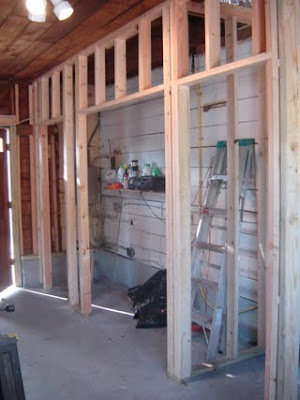To enclose our utility area and create a separate closet for our new room that used to be a garage I needed to build a wall. Much of the wall would be doors to access the closets. Framing is an exciting phase of the project because it seems to go so fast compared to other parts of the project. Before we get ahead of ourselves let’s think this through.
 In the end of the closet is the service panel with all the circuit breakers for the entire house. By codes, this needs at least 30″ of clearance to the sides and 36″ in front of it. I also need to make sure that the washer/dryer fit in the closet with wiggle room. I decided to make the interior of the closet 34″ deep to satisfy these criteria.
In the end of the closet is the service panel with all the circuit breakers for the entire house. By codes, this needs at least 30″ of clearance to the sides and 36″ in front of it. I also need to make sure that the washer/dryer fit in the closet with wiggle room. I decided to make the interior of the closet 34″ deep to satisfy these criteria.
Next, I needed to place the doors. I wanted a normal 30″ 6-panel door on the end to access the service panel and a small mud sink. Next, I planned for a 60″ opening with bi-fold doors that would hide the laundry appliances. The interior of the laundry/sink/service panel closet will be open inside with no dividers. Because of all the wiring and plumbing in that area I’m not changing this wall. Just enclosing the area.
Beside the laundry will be a small closet to add storage to this room enabling the room to function as a bedroom if someone wanted use it for that. With doors so close together I also had to think ahead about how the trim would be installed. I’ll be using 2 1/4″ casing and I didn’t want the trim from adjacent doors to get in the way of each other.
Once I had the wall designed on paper, I started by laying it out on the floor using chalk lines to show where the floor plates will go. I marked the doorway rough openings, leaving room for doorjambs, which add approx. 2″ to the width of a door. For these 30″ doors I’m making the rough opening 32″. This allows for 1 1/2″ of door jambs (2 pieces at 3/4″ each) and then 1/2″ of space to shim and make sure I can get it level.
The bottom plates will be treated 2×4 as required by codes because they are resting on the cement slab. I spread a little liquid nails underneath and then secured the bottom plates to the cement using a Ramset.  This is a ‘powder actuated’ tool that literally shoots the nail through the lumber into the concrete using small caliber loads. I have the most basic single-use model that is triggered by me hitting the top with a hammer. If you have to use it a lot, they make various models up to the .27 caliber semi-automatic. (Check them out here.)
This is a ‘powder actuated’ tool that literally shoots the nail through the lumber into the concrete using small caliber loads. I have the most basic single-use model that is triggered by me hitting the top with a hammer. If you have to use it a lot, they make various models up to the .27 caliber semi-automatic. (Check them out here.)
 This is a ‘powder actuated’ tool that literally shoots the nail through the lumber into the concrete using small caliber loads. I have the most basic single-use model that is triggered by me hitting the top with a hammer. If you have to use it a lot, they make various models up to the .27 caliber semi-automatic. (Check them out here.)
This is a ‘powder actuated’ tool that literally shoots the nail through the lumber into the concrete using small caliber loads. I have the most basic single-use model that is triggered by me hitting the top with a hammer. If you have to use it a lot, they make various models up to the .27 caliber semi-automatic. (Check them out here.)
Anyway, the Ramset is a great alternative to some type of masonry nail or even using Tapcon screws with a hammer drill. I was using 2 1/2″ fasteners that were meant for use in treated lumber.
You might note that the header above each door is only a flat 2×4. Since this is a NON-loadbearing wall, this is all that’s needed. Of course, if it was supporting a load above it, we’d need something more substantial.
Things are starting to take shape. Next, let’s build some steps to get into the room.
-Peter









